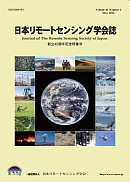
- Issue 4 Pages 223-
- Issue 3 Pages 43_3x1-
- Issue 2 Pages 73-
- Issue 1 Pages 1-
- Issue Supplement Page・・・
- |<
- <
- 1
- >
- >|
-
S. KAMEYAMA2023 Volume 43 Issue 3 Pages 43_3x1
Published: August 10, 2023
Released on J-STAGE: September 20, 2023
JOURNAL FREE ACCESSDownload PDF (447K)
-
Go Segami, Kei Oyoshi2023 Volume 43 Issue 3 Pages 137-146
Published: August 10, 2023
Released on J-STAGE: September 20, 2023
Advance online publication: August 08, 2023JOURNAL FREE ACCESSLand surface temperature (LST) data generated by optical satellites are utilized in many fields, including agriculture. However, many LST data can be missed under cloudy conditions, which limit the use of LST data for monitoring crop growth, for example. Our study evaluated AMSR2 and MODIS LST data to better understand the characteristics of LST data collected by microwave radiometers, which are less sensitive to weather conditions, compared to those collected by optical sensors, in order to enhance their complementary use.
The AMSR2 LST loses little data during the tropical rainy season, while the MODIS LST loses considerably more. This strongly suggests a major benefit of employing both types of data. If the monthly mean LST is calculated using LST data from only sunny days, it is 1.5-3 °C higher than the average of all days, indicating that optical sensor data have a clear-sky bias. We compared the MODIS and AMSR2 LSTs, evaluating them against global land cover. The root-mean-square difference for forested areas was found to be small at less than 3 °C, but is larger (less than 4 °C) for land cover such as rice paddies, where land surface emissivity varies greatly with seasonal changes. The bias characteristics also vary by land cover and day/night. This indicates a need to consider land cover in complementary utilization. AMSR2 LST data was able to detect extremely high global temperatures in July 2021. This indicates that it is appropriate for monitoring extreme global events. It is necessary to develop methods of complementary utilization and integrated usage that take advantage of the characteristics of both types of LST data, and to develop a microwave radiometer LST that takes land surface emissivity into account.
View full abstractDownload PDF (6160K)
-
Saki Miyamoto, Kanako Muramatsu2023 Volume 43 Issue 3 Pages 147-153
Published: August 10, 2023
Released on J-STAGE: September 20, 2023
Advance online publication: August 01, 2023JOURNAL FREE ACCESSAn algorithm for estimating gross primary productivity (GPP) under low stress (GPPcap) based on the green chlorophyll index (CIG) was developed by Thanyapraneedkul et al. in 2012, and its parameters have been determined for several vegetation types, including paddy fields. Although it is not yet possible to correctly classify precise crop types globally by using satellite data, this algorithm can be easily applied for various types of crops when the same parameters are used. The Sentinel-2/MSI (MultiSpectral Instrument) has red-edge bands, and red-edge bands were reported to be more sensitive than a green band for determining amounts of chlorophyll. In this study, we sought to identify the optimal band of the chlorophyll index (CI) among green and red-edge bands at 705 nm and 740 nm for estimating the GPPcap at 2000 μmolm−2 s−1, i.e., GPPcap (2000) in maize and soybean for irrigation and no-irrigation conditions, by using flux data from the US-Ne1, US-Ne2, and US-Ne3 sites. We observed a higher correlation between the CIRE at 705 nm and GPPcap (2000) than the other pairs of parameters, and the differences of the parameters for the GPPcap (2000) estimation were smallest for the CIRE at 705 nm for maize and soybean. We also converted a prior study’s rice paddy CIG result to that with a CIRE at 705 nm. This result implies that the same parameters can be used among maize, soybean, and rice paddies in GPPcap (2000) estimations.
View full abstractDownload PDF (668K)
-
Tomohiro Sugaya2023 Volume 43 Issue 3 Pages 154-158
Published: August 10, 2023
Released on J-STAGE: September 20, 2023
JOURNAL FREE ACCESSDownload PDF (6160K)
-
H. TONOOKA2023 Volume 43 Issue 3 Pages 159-162
Published: August 10, 2023
Released on J-STAGE: September 20, 2023
JOURNAL FREE ACCESSDownload PDF (3414K)
- |<
- <
- 1
- >
- >|